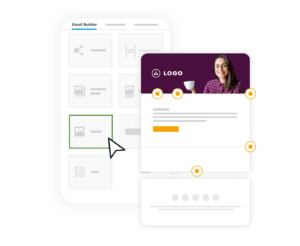5 Solutions for Making CRM More Accessible
In times when we rely even more on technology to get our daily work done, CRM tools need to become user-friendly. Our recent research uncovers that 76% of the sales and marketing leaders think their CRM is too complex, not intuitive, and can’t be customized adequately to their needs. An intuitive interface is the first step to encouraging companies to use a CRM system. Therefore, you should consider adding assistive technologies and inclusion policies for an improved user experience.
Having accessibility as a key objective of any customer-related project drives better engagement for both employees and customers, resulting in better business outcomes. Accessibility is not a feature; it’s a journey and is becoming increasingly important for any safe, modern work environment.
How to Make CRM More Accessible
Customer relationship management tools are all about building relationships with customers, preferably on their terms. Besides focusing on cultural differences, preferred communication channels, and language usage, you should take an accessibility initiative—making your tool understandable and easy to use by people that experience some level of physical or mental impairment.
We’ve compiled five easy steps in following the best CRM solution design and configuration practices.
1. Work with others who have accessibility needs and with your team to determine potential issues that need to be solved.
Sometimes impartments are challenging to define because they may not always be visible or permanent. Having a leader accountable for accessibility efforts helps put together a strategy and prevents missing any vital accessibility issues that you should address.

To improve all user experiences, we need to find accessible solutions for all common disability categories. You can start by asking these questions, then build up from there:
- Can users with low vision apply zoom on the text or images?
- Can users override font settings? People with dyslexia usually prefer it.
- Do your audio materials pair with visual cues and captions?
- Do your error messages give explanatory context? It improves problem-solving capabilities.
- Do you use visual cues to highlight the most important points of a content piece? It helps people who have trouble focusing their attention.
- Are your processes short and provide constant reminders? They help people with memory deficiency.
- Do you provide supplemental media to help your processes for better reading and verbal comprehension?
It’s essential to help your customers evaluate assistive technologies to get the best result for each user or group of users. Be supportive by sharing your experience working with other customers with accessibility needs so they feel inspired and encouraged to give you feedback.
2. Tailor the user interface for specific users or groups of users.
74% of consumers say “living profiles” with more detailed personal preferences would be helpful if they were used to curate personalized experiences, products, and offers.
Tailor the user interface for specific users or groups of users, where necessary. This can be done through specific CRM apps. You must keep tool navigation simple and enable users to personalize form layouts by choosing their preferred color scheme, larger fonts, and highly contrasting colors or using fewer graphics.
3. Incorporate alt tags and screen readers.
Screen readers are an assistive technology helpful not only for persons with visual impairments but also for elderly people. It’s also a great navigation tool, allowing users to preview information and skip to the desired page section. Most screen readers can be accessed only using the keyboard, providing precise navigation to the next item of the page or document by hitting the Tab key. That’s why it is vital to include headings that make your content easily accessible. Screen readers are an excellent tool for testing accessibility issues because they confirm the flow of your page.
Annotate your images and graphics using the ALT tag, so screen readers will be able to describe a picture. Also, it makes navigation through graphical pages much easier.
4. Always include a text version of your emails.
Marketing automation tools, like Sugar Market, now provide easy drag-and-drop editors and HTML coding capabilities, making it easy for everyone to design creative email templates. But always have available a text-only version of your emails. They are more accessible for screen readers to understand. Besides, your images might not display correctly depending on the browser or recipient’s email settings. Text-only version emails are the safe way to keep your customers close and have a good sender reputation.

5. Integrate keyboard-to-voice or voice-to-text engines.
Creating accessible experiences for individuals with disabilities leads us to a future of inclusion. They guarantee each individual an equal user experience, no matter their disabilities.
Enabling a voice typing engine can help a person with a hand motor incapacity continue their activity. The same for text-to-speech solutions; they help people with speech and visual impairments, so the message is clear and comprehensible for everyone, even those with low reading skills, who will benefit from an audio alternative.
Make Your CRM More Accessible with SugarCRM
Assistive technologies are committed to making things accessible for all people by putting the users in control of their experience.
Sugar enables users to quickly perform specific tasks using keyboard shortcuts to increase productivity and accessibility. Keyboard shortcuts can be used to navigate the list views and record view layouts, allowing users to quickly select and inline edit or preview records.
Users can also customize the key combinations which activate each shortcut.
Using the Tab key (Alt+Tab for Safari browser) on your keyboard enables you to easily navigate through Sugar’s navigation bar, which spans across the top of the screen. Besides its native accessibility initiatives, Sugar gives you access to more accessibility tools through multiple add-ons and integrations.
Closing Thoughts
We’ve promised to make things easier, so we want to respond to the needs of all our users and make the most of their talents. SugarCRM focuses on keeping activity tailored for every role, all visually represented in a single tab, making it more intuitive and contextual.
We believe that technology should work for people, not the other way around, and accessibility plays a major part in doing so. If you want to learn how to create great experiences for both users and customers, reach out to us and request a demo.



